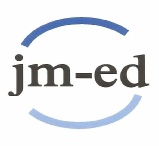
jm-






Transforming ideas into musical lyrics & song sections: Verses, Chorus and Middle 8


‘I’m Arising’ by Chloe Lawrence
Chloe Lawrence is a teenage singer-
With 'I'm Arising,' Chloe started off with the lyrics.

Work on 'I'm Arising' began when Chloe was asked to perform one of her songs at an upcoming school concert to celebrate fireworks night.
Intent on writing something original and with a theme that would reflect the occasion, Chloe got to thinking about the usual things associated with this night -
So the lyrics would have to convey all of these aspects.
Original key: F major
Subdominant key: Bb major (built on chord IV in the key of F major)
Dominant key: C major (built on chord V in the key of F major)
Relative minor key: D minor (built on chord VI in the key of F major)
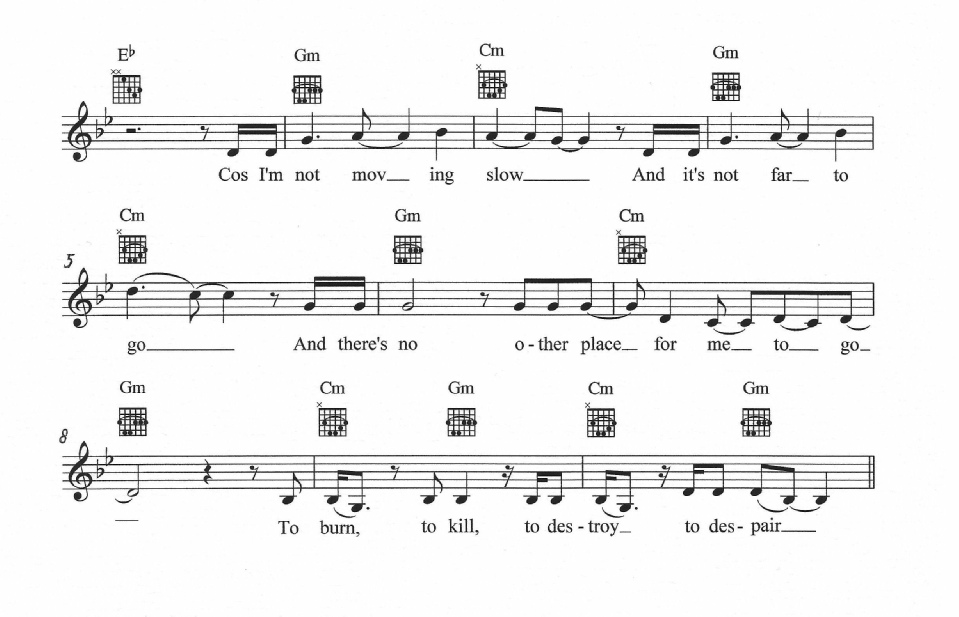


Here are the first lyrics Chloe wrote.


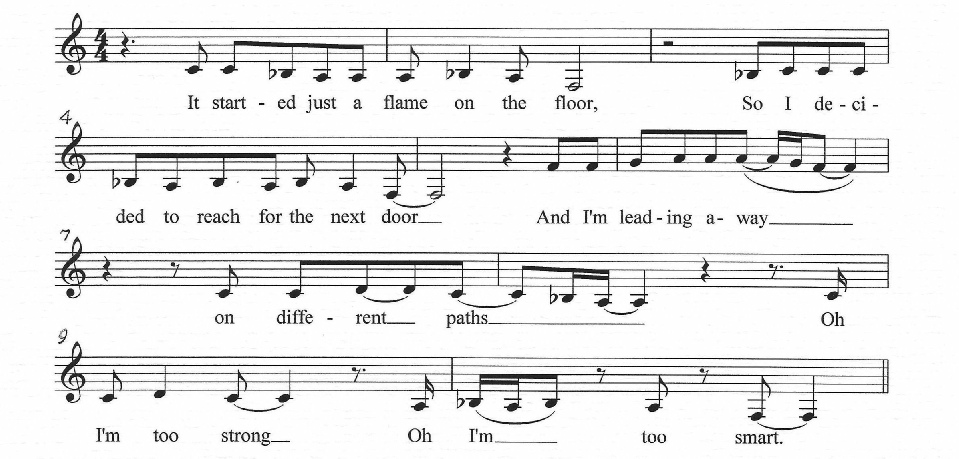
Verse 1


After some experimentation playing the above chords on acoustic guitar whilst singing the lyrics of the first verse, Chloe felt that a single F major chord fitted best with the whole melody, but to prevent this becoming too monotonous she alternated it with an *F sus4 chord, which would vary the sound a little whilst still keeping the F major chord harmony. An F sus4 chord is simply an F major chord with the fourth note of its scale (Bb) added. The term 'sus' is an abreviation of 'suspended' because the addition of the fourth note makes all chords sound like they are 'suspended' waiting for another chord or note to follow that will allow them to 'fall' or relax again (for more information on this see the Tip Maestro below).
Chloe's next task was to decide on a suitable tempo and accompaniment rhythm. Both of these musical elements can alter the character of a song significantly, so they had to be chosen with care.
The mood and theme of the song didn't seem suited to either a particularly slow or fast beat, so an Andante tempo was settled upon, with a precise metronome speed of 92 bpm (92 beats per minute). To keep the rhythm fairly active, though, Chloe opted for a lively chord accompaniment played on acoustic guitar.
The music below shows this strummed guitar accompaniment on a separate stave underneath the melody, with guitar chord boxes appearing above the lyrics (this is the standard layout in musical notation). The key signature of F major has also been added.

Note: ad.lib. is an abbreviation of ad libitum, meaning 'at liberty,' which in this case means the notated rhythm can be varied a little at the player's discretion. Sim. is an abbreviation of similar, and just indicates that the player should go on playing the chords in the same or a similar rhythm.
The musical symbol means this bar should repeat the music of the previous bar.

Middle 8

All that remained to be composed now were the Coda and intro sections

If you can, play (or have someone play) the above chord progressions in the keys of F major and G major. Notice how the music sounds suspended on the second chord in each key and relaxes again on the third. The added 9th chords will probably sound a bit 'jazzy' to your ears.
Try repeating this exercise with other chords, in each case adding the fourth and ninth notes of the scale to create suspended 4th and added 9th chords. For extra guidance with this you will probably find it helpful to refer to Keys, Scales and Chords in the Reference Page of this website.
|
|




A
ctivity Time Exercise
Listen to 'I'm Arising' again and focus on the drums to hear what Chloe composed for this part. Pay close attention at the section changes and notice how drum fills and hi-
|
|




A
ctivity Time Exercise
Listen to 'I'm Arising' again and this time focus very carefully on the bass guitar part. It's possible that until now you weren't even aware of its existence because it plays quite subtly in the background. This is often the case with song accompaniment parts when they are 'mixed' well (neither too loud nor too quiet), since they are doing their job of enhancing the overall sound without getting in the way of the more important lead vocal.
Backing Vocals

|
|




A
ctivity Time Exercise
Listen to 'I'm Arising' once again and focus on the backing vocals. Notice how Chloe chooses only certain points in the song for her backing vocals, and how these are normally places where the stronger emphasis benefits the melody. Notice also that she uses both unison singing and small touches of countermelody, and that sometimes the backing vocals are very subtle and other times more obvious; used on whole phrases or just a single word.



The first two lines are about a firework -
With these four lyrical phrases (which Chloe decided would be best suited for the chorus) the song was already well under way. The natural rhythm (metre) and mood of the words would help in the choice of musical key and rhythm not only for the chorus but, to a large extent, for the rest of the song too.
The next task, then, was to write lyrics for the verses. Here, Chloe chose to develop the theme of Guy Fawkes starting the fire and moving stealthily along the corridors of the House of Lords, confident in his political conviction to destroy the building!

I’m arising over the hillside. I’m arising, I’m arising.
I’m burning along, and I’m singing a song,
I’m a man, I’m a story, I’m a flame,
I’m a firework, I am terror, I am shame.

At this approximate halfway stage in the song, Chloe felt that now would be the best time for a Middle 8 as it would provide a nice element of contrast, breaking up the predictability of a constant verse-
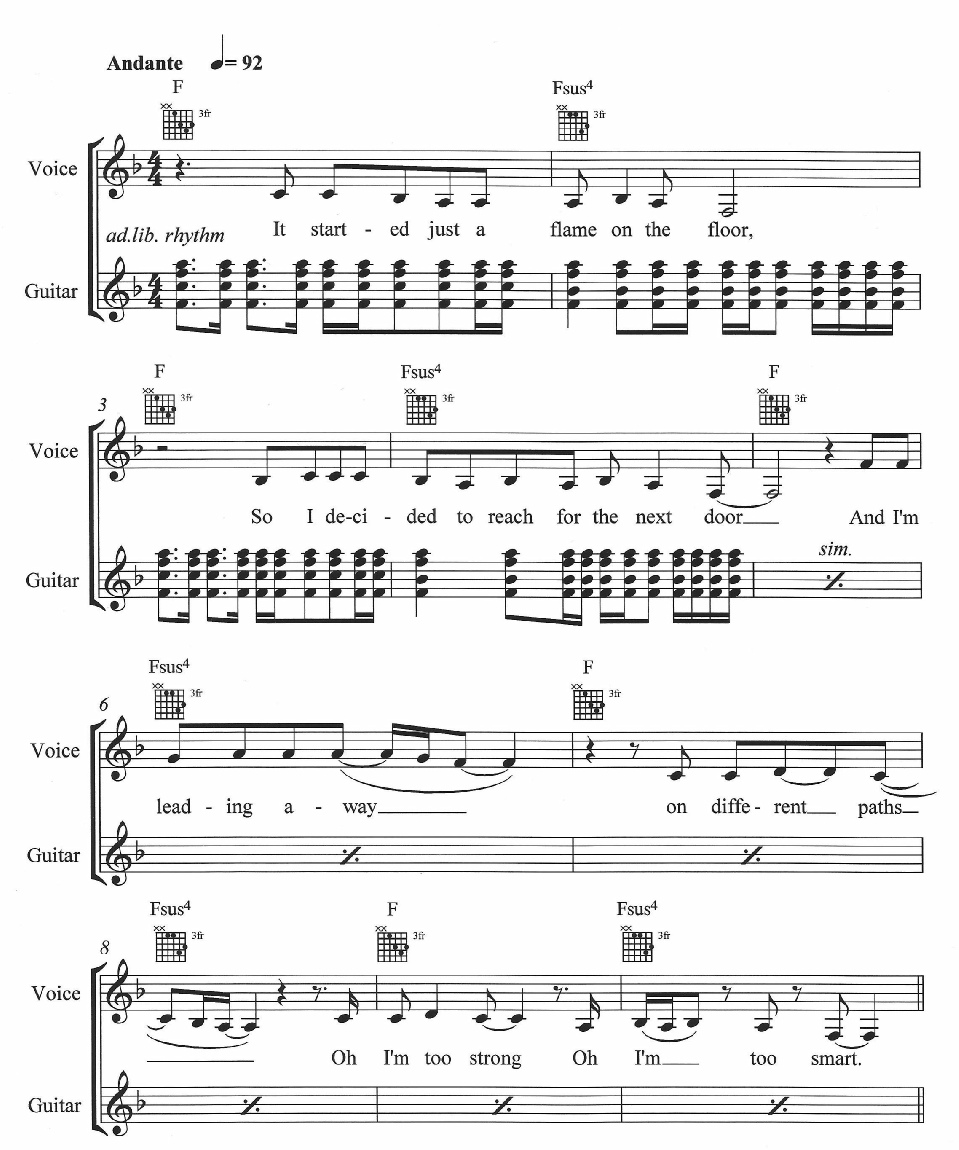
Verse 1 with guitar chords and accompaniment rhythm


With musical key, harmony, tempo and accompaniment rhythm worked out for just one verse, the main components of the song were already well established.



Virtual Tablet




Click here

Verse 1 (excerpt heard at 0.18)
You can hear the music for verse 1 by accessing the examples for this workshop at the above YouTube link. Listen to it as you follow the notation above or on screen during the excerpt. (Note: the excerpt you will hear has accompaniment added.)
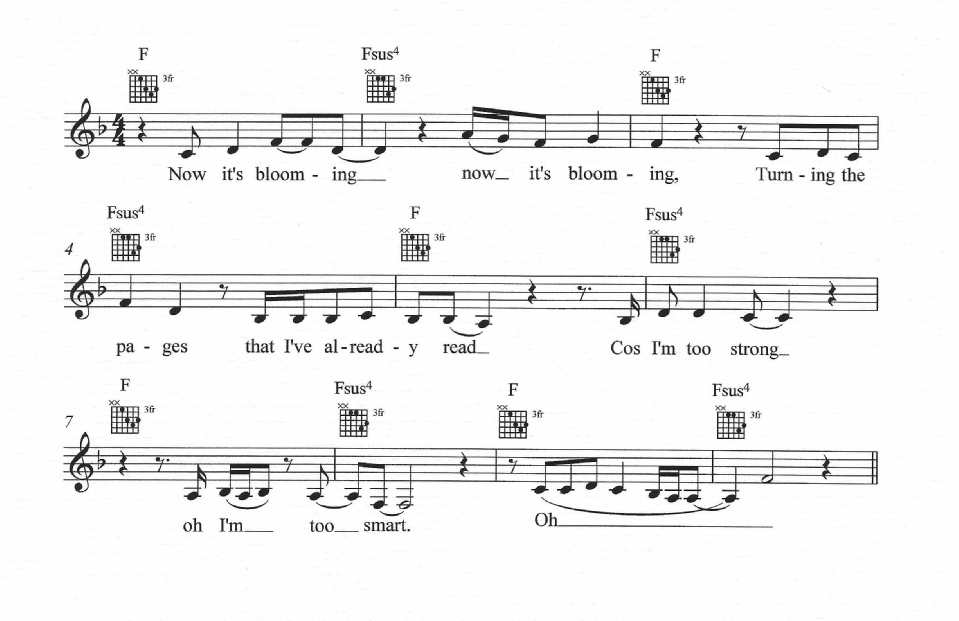

Verse 2

For the second verse of her song, Chloe would return to the key of F major, keeping the music of this next section thematically similar to verse 1, but for a little variation she would make the pitch slightly higher -
Verse 2


Following the structure plan for this song a repeat of the chorus would now follow, meaning the next section requiring original music to be composed was the middle 8.

To add more creative contrast in 'I'm Arising' Chloe had another key change here, and this time she picked G minor, which is the relative minor key of Bb major -
Only two different accompaniment chords are used throughout this contrasting section (the Eb major chord in bar 1 just functions as a link chord): these are G minor (chord I) and C minor (chord IV). The use of a minor key for the first time in the song, combined with the repetitive alteration between the two minor chords is effective in expressing the darker nature of the lyrics.
This sudden contrast in the song keeps everything interesting and free from monotony -

Chloe deviated slightly from her original plan once again in this section. Singing all the sections in order, she now felt that instead of having the intended acoustic guitar solo instrumental it would sound better to have an improvised vocal section with some scat singing here. Such spontaneous changes are common with composers and songwriters, since new (and better) ideas often only present themselves when a piece of music is well under way.
Chloe's new improvised vocal section (which she still considered an instrumental of sorts) would be in the same key and have the same chord progression as the chorus.
Here is the result:

The Coda
To round off her song, it instinctively felt right to Chloe to repeat the second part of the chorus containing the lines 'I'm a man, I'm a story, I'm a flame... I'm a firework I am terror I am shame' as they summed up the meaning of the whole song. To emphasise this further (and to expand the Coda a bit more), she repeated the first part of the lyric so that the line became: 'I'm a man, I'm a story, I'm a flame... 'I'm a man, I'm a story, I'm a flame. I'm a firework I am terror I am shame.'
Verse 1



Headed by the opening phrase, 'It started just a flame on the floor,' these four lines were perfect for the first verse as they began telling the story of Guy Fawkes and his (or the fire's) movement inside the government building on the fateful evening of 5th November 1605.
For the second verse Chloe chose to continue the story with a developing fire – which might be the one inside the House of Lords or the much larger one inside Guy Fawkes’s own imagination!

Verse 1
It started just a flame on the floor,
So I decided to reach for the next door,
And I’m leading away on different paths
Oh I’m too strong, oh I’m too smart.
Verse 2



Notice the repeat of the line 'Oh I'm too strong, oh I'm too smart' from verse 1. This repetition will help preserve a sense of unity in the song but it is also effective in suggesting a repetitive narrative inside Guy Fawkes's head and the strength of his misguided, perhaps arrogant conviction. This verse is just three lines long as opposed to four in verse 1.
With the lyrics of the first two verses and the chorus now complete, the song’s structure looked like this:

| Verse 1 | Chorus | Verse 2 | Chorus |

Verse 2
Now it’s blooming, now it’s blooming,
Turning the pages that I’ve already read.
Oh I’m too strong, oh I’m too smart.

Step 2. Composing the Music

Before sitting down to compose the music for a song it's worthwhile taking some time to consider who is likely to be singing it -
Chloe would be singing and recording this song herself, so she knew the vocal range (how high and low her voice could reach), and there would be both major and minor keys -
Chloe did know that she wanted the verses to be lower in pitch than the chorus. There were two reasons for this; one, to heighten the effect of the chorus (by creating contrast) and two, to emphasise the transformation of the 'dark' verse lyrics into the 'light' lyrics of the chorus.
As she would be singing 'I'm Arising' herself, Chloe’s own voice could dictate the lowest notes of the verses and the highest notes of the chorus. She has the capacity to sing fairly low for someone of her age, and this would of course increase the potential for a wide note range in the song.
So, beginning at the lower end of her vocal range, Chloe improvised the lyrics of each line of the first verse to a few random notes, listening to which note passages worked, and slowly developed the music one line at a time.
From this vocal improvisation the first verse was eventually formed.
Choosing notes and pitch to suit the mood of the lyrics and the singer’s vocal range

Middle 8


Strengthening the element of contrast in this section are the darker lyrics in the fourth line which could be describing the fire itself or portraying Guy Fawkes's feverish intent to 'burn,' 'kill,' 'destroy' and cause 'despair.' Chloe also made the decision to have a brief modulation to a more serious sounding minor key when she came to write the music for this section.
Another repeat of the chorus would follow the middle 8 but after this, and again to avoid predictability, Chloe wanted a short instrumental section played on acoustic guitar which would link to a final repeat of the chorus and then a Coda to complete the song. An instrumental introduction (or intro) would also be added at the start of the song, but this would be left until all the other music had been composed since intros often contain a 'flavour' of what is to come and are therefore easier to put together when all the melodies and chords have been worked out.
The full song structure plan now looked like this:
This plan could of course be altered during the music composing process, but at this early stage it was a strong foundation on which to start building the song. There was an intro and Coda; verses and a chorus; a middle 8 halfway through; and an instrumental 'break.' There were only two verses but another could be added if the balance of the song required it, and this would only be known when the music was being composed.

Intro | Verse 1 | Chorus | Verse 2 | Middle 8 | Chorus | Instrumental | Chorus | Coda



The next logical step was to set the chorus lyrics to music. The mood of this section is lighter than the verses and Chloe of course wanted that to come across in the music. From the start of the composing process she had decided to make the chorus livelier, probably with a key change as well, and have the music in a higher pitch than the verses. Remember that this was to provide contrast but also to distinguish the 'light' of the fireworks from the slightly 'darker' character of the verses.
Common key changes would be to Bb major (from chord IV of F major -
After some experimenting with the scale notes of the above keys, the decision was made to have a key change to Bb major, the dominant key, as Chloe felt it best suited both her vocal range and the mood of the chorus. The notes in this scale are: Bb, C, D, Eb, F, G, A.
Below is the melody she composed in the new key of Bb major, complete with guitar chord boxes showing where each chord change occurs. (In this new key only chords I, IV and V are used to harmonise the music: Bb major is chord I, Eb major is chord IV and F major is chord V.) Notice the higher pitch of the notes in this chorus melody compared to those of verse 1).
Chorus

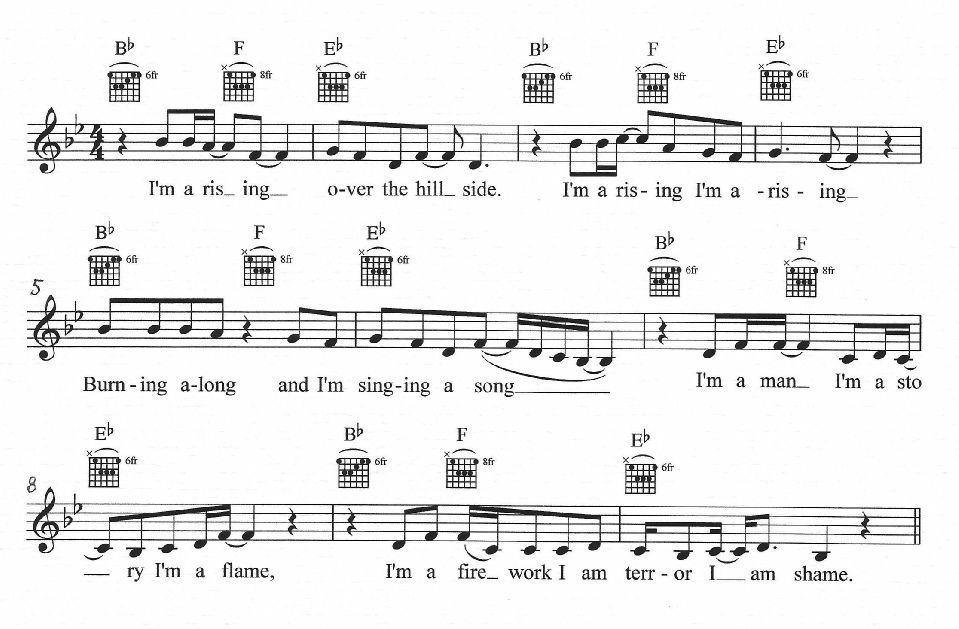
Chorus




Virtual Tablet




Click here

Chorus (excerpt heard at 0.53)
You can hear the music for the chorus by accessing the examples for this workshop at the above YouTube link. Listen to it as you follow the notation above or on screen during the excerpt. (Note: the excerpt you will hear has accompaniment added.)



Virtual Tablet




Click here

Verse 2 (excerpt heard at 1.33)
You can hear the music for verse 2 by accessing the examples for this workshop at the above YouTube link. Listen to it as you follow the notation above or on screen during the excerpt. (Note: the excerpt you will hear has accompaniment added)
The Middle 8 Section




Virtual Tablet




Click here

Middle 8 (excerpt heard at 2.11)
You can hear the music for the Middle 8 by accessing the examples for this workshop at the above YouTube link. Listen to it as you follow the notation above or on screen during the excerpt. (Note: the excerpt you will hear has accompaniment added)
The Instrumental section




Virtual Tablet




Click here

Instrumental (improvised vocal) (excerpt heard at 2.46)
You can hear the music for the improvised vocal section by accessing the examples for this workshop at the above YouTube link. Listen to it as you follow the notation above or on screen during the excerpt. (Note: the excerpt you will hear has accompaniment added)
Adding a Coda and Intro




Virtual Tablet




Click here

Coda (excerpt heard at 3.19)
You can hear the music for the Coda by accessing the examples for this workshop at the above YouTube link. Listen to it as you follow the notation above or on screen during the excerpt. (Note: the excerpt you will hear has accompaniment added)

The Intro
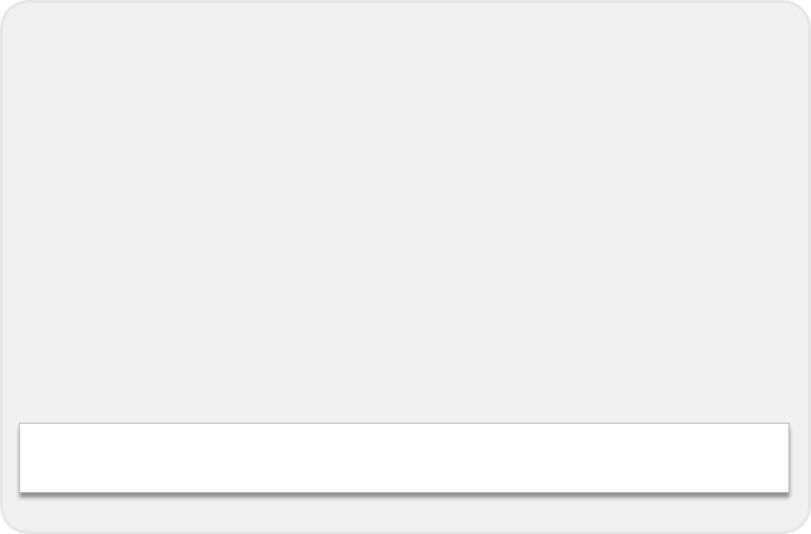
As mentioned earlier, a song’s intro is often easier to write once the other parts of the song have been composed and the important elements (melodies, keys, chord progressions, etc) are known since these can be used to write an intro that gives a 'flavour' of the song to come.
For her intro, Chloe decided to begin with a chord sequence (played on acoustic guitar) based on the song's verses but with the addition of a new chord, *F9. For a little variation she played these as arpeggios and in a different time signature (3/4 time) to the rest of the song. Furthermore, the arpeggios were played in a syncopated rhythm -
The phrase of arpeggios lasts for seven bars, after which Chloe thought it would be good to return to 4/4 time with a short passage where the same chords were strummed (bars 8 & 9) as this would introduce the main accompaniment style of the song: strummed acoustic guitar chords.
Here is the music showing all of these features. Notice how the tenuto marks (the lines above the notes) produce a syncopted rhythm.
Note: a single bar in 2/4 time (bar 7) was used to smoothly join the arpeggios with the strummed chords in 4/4 time (bar 8).



Virtual Tablet




Click here

Intro (excerpt heard at 3.56)
You can hear the music for the intro by accessing the examples for this workshop at the above YouTube link. Listen to it as you follow the notation above or on screen during the excerpt. (Note: the excerpt you will hear has accompaniment added)
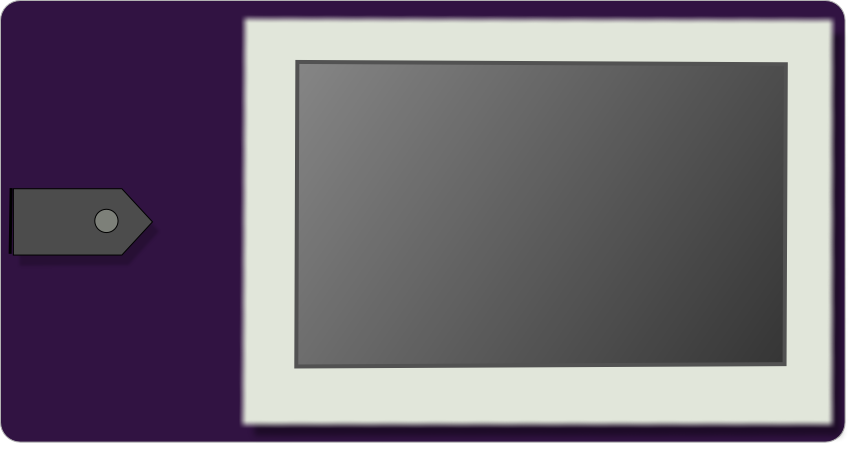
Virtual Tablet




Click here

Complete Song (excerpt heard at 4.30)
You can hear how the individual sections were put together (complete with link passages) in the finished song by accessing the excerpts for this workshop at the above YouTube link or listening to CD track 34 of How to Pass National 5 music. Notice how the link passages create a smooth flow between main sections. If you wish, follow the music below as you listen.
Bass Guitar Track




Virtual Tablet




Click here

Complete Song (excerpt heard at 4.30)
Listen to 'I'm Arising' one final time now and pay attention to how each accompaniment part contributes to the overall song, thanks to good composing and some careful sound engineering or 'mixing' (achieved mainly through balancing the individual volume settings of each part).

Step 1. Writing the lyrics
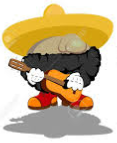
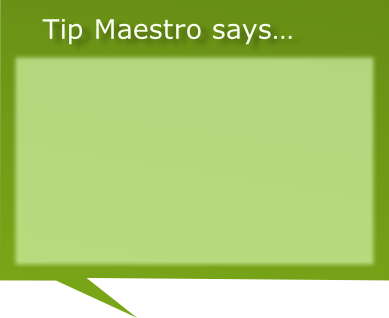
‘Sometimes song lyrics have a personal meaning or significance to the composer which is not always immediately obvious to listeners. This ambiguity is not a problem, however, as it can create an element of mystery or intrigue, making listeners ponder the words more, or ascribe their own meaning to a song. People don’t mind doing this, especially if the music is good!’



Suspended 4th (or sus 4) chords and 9 (or added 9th) chords
‘To better understand these chords we need only consider the musical scale of the chord itself. Every basic chord is made from the 1st, 3rd and 5th notes of its scale, so the chord of F major is constructed with the notes F, A and C (see example below). Therefore, an F suspended 4th (or F sus 4) has the 4th note, a Bb, added to the basic chord, and an F9 has the 9th note added (which is easier to understand when the scale scale is observed continuing beyond one octave -

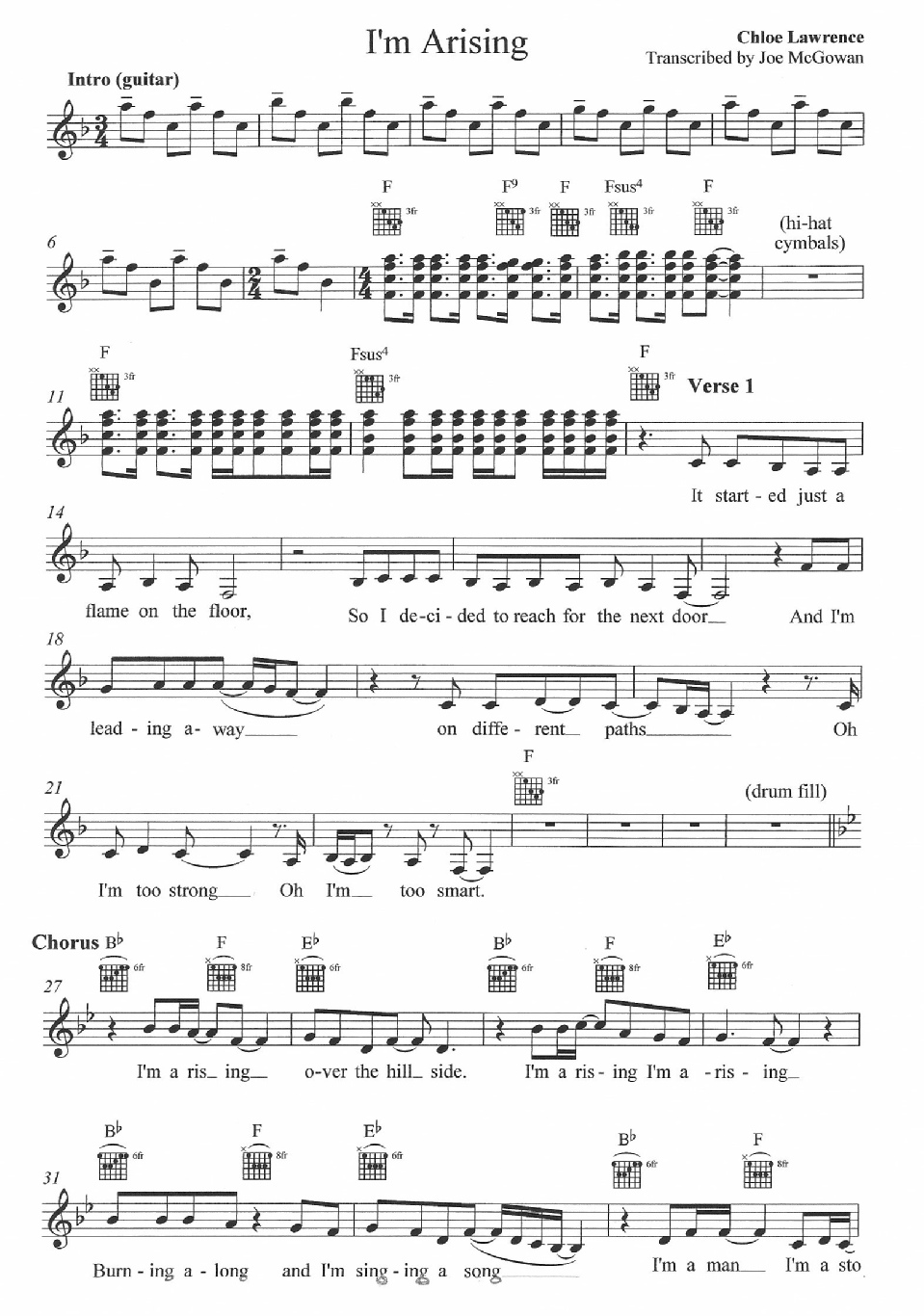
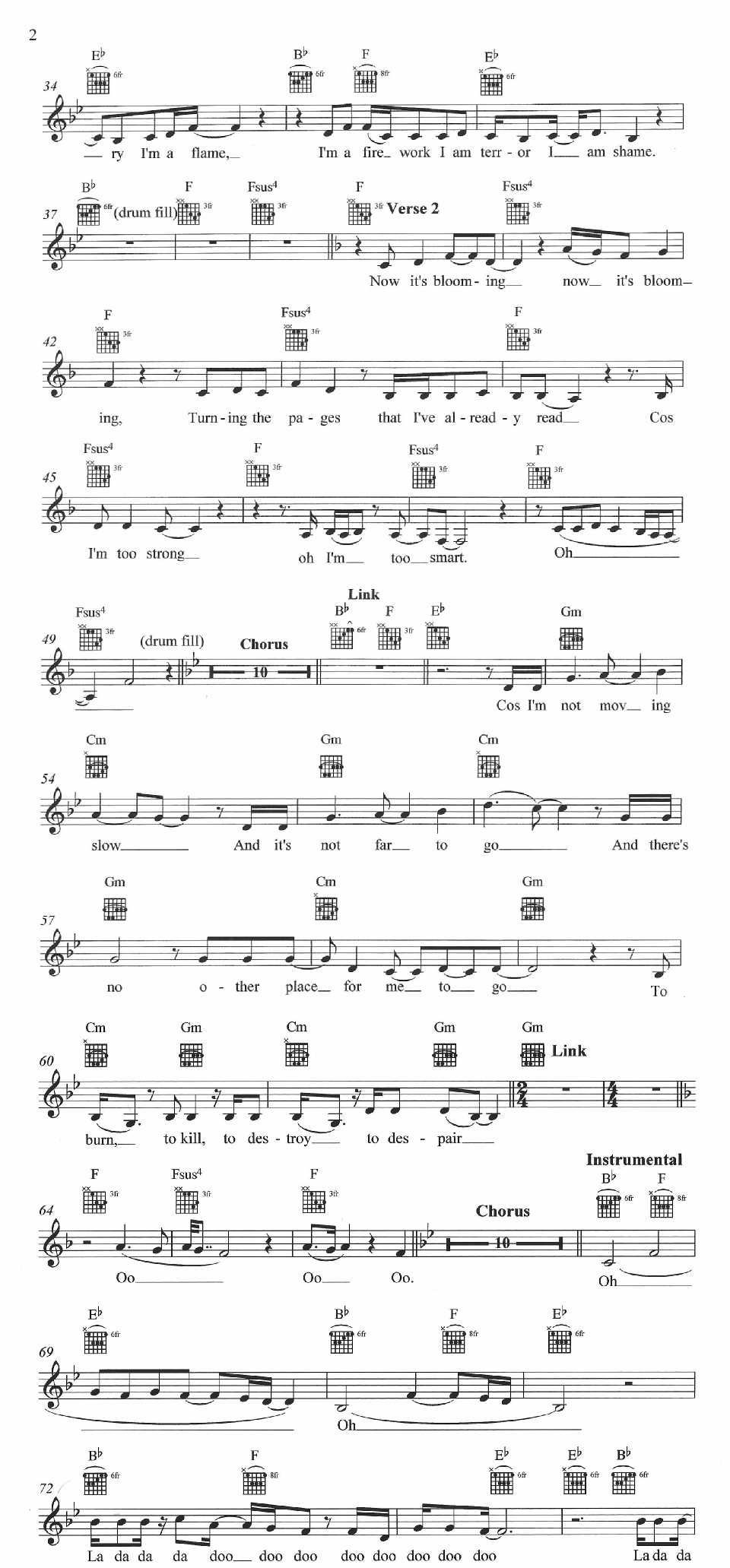
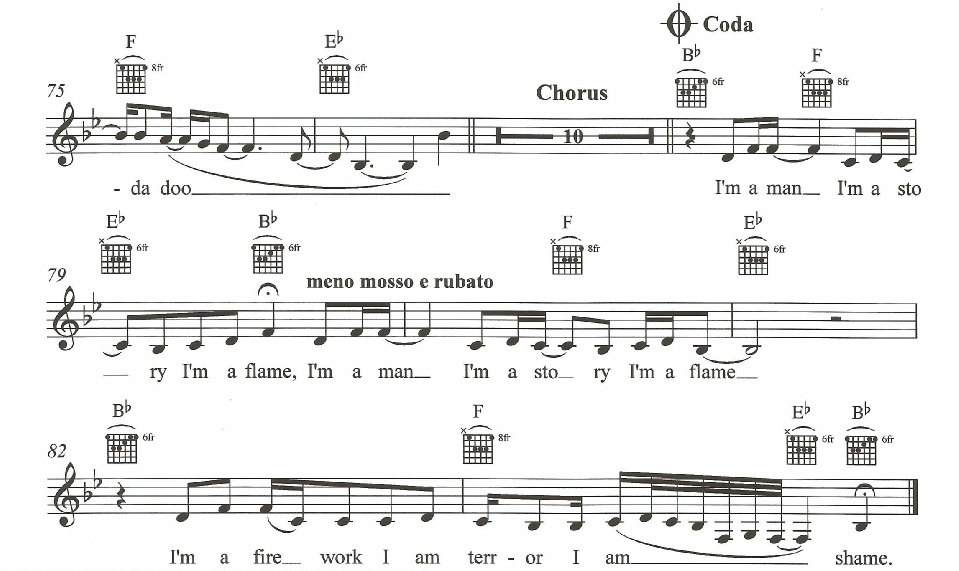
The Complete Song in Music Notation


Middle 8
Cos I’m not moving slow,
And it’s not far to go.
And there’s no other place for me to go,
To burn, to kill, to destroy, to despair.
Linking the Sections Together


Song Writing Workshop: Analysing a Modern Song

Drum Track


Step 3. Accompaniment Parts


This workshop examines a song by a school music student who was just thirteen when she composed and recorded it. Each step of the composing process is listed below; clicking on a link will take you directly to that particular section.
Step 1: Writing the lyrics
Step 3: Accompaniment parts
Step 2: Composing the music
The song used in this workshop, 'I'm Arising' by Chloe Lawrence, can be heard on track 34 of the CD which accompanies the book, How to Pass National 5 Music, and on YouTube by clicking here. You can also hear more of Chloe's songs at www.chloel.com
(You might also find it helpful to refer to Adding Accompaniment Parts to a Melody (chapter 4 supplementary material)

Home | About | News | National 5 Music | Higher Music | Shop
Resources | Charity | Contact | Tuition | Links
Copyright © Joe McGowan 2016

Analysis of the main musical elements (or concepts) in verse 1:
* Short phrases consisting mainly of quavers (eighth notes). Other note values are crotchets (quarter notes), minims (half notes) and semiquavers (sixteenth notes)
* Rests used are dotted crotchet rest, minim rest, crotchet rest, quaver rest and dotted quaver rest
* Tied notes (on the words 'door', 'away', 'different', 'paths', 'strong'and 'smart')
* Mainly sylabic word setting with some melismatic used (on the words 'away', 'paths' and 'I'm' (in the last bar))
* Mainly stepwise melody
* Anacrusis in most bars
* On the beat and Off the beat notes/lyrics
* Syncopation occurs in bar 2 (between beats 1 & 2), bar 4 (between beats 3 & 4 and in the final quaver tied into bar 5), bar 6 (produced by tied notes), bar 7 (produced by tied notes), bar 8 (produced by tied notes), bar 9 (between beats 1 & 2 and in the tied note on beat 3) and bar 10 (between beats 2 & 3 and in the tied note on beat 4)

Range: The lowest note in the melody is F below middle C. (This is rather low for a female vocal but just within Chloe's own range.) The highest note is A above middle C, making the range of this verse just under one and a half octaves.
Key: The notes of this opening melody would determine both key and harmony (the accompaniment chords). The presence of Bb notes combined with the fact that the music could end comfortably on the note F make this the key of F major. Notice that four of the six phrases end on F. The chords in this key are: F major, G minor, A minor, Bb major, C major, D minor, E diminished. (For more information on this key see Keys, Scales and Chords in the Reference Page of this website.)
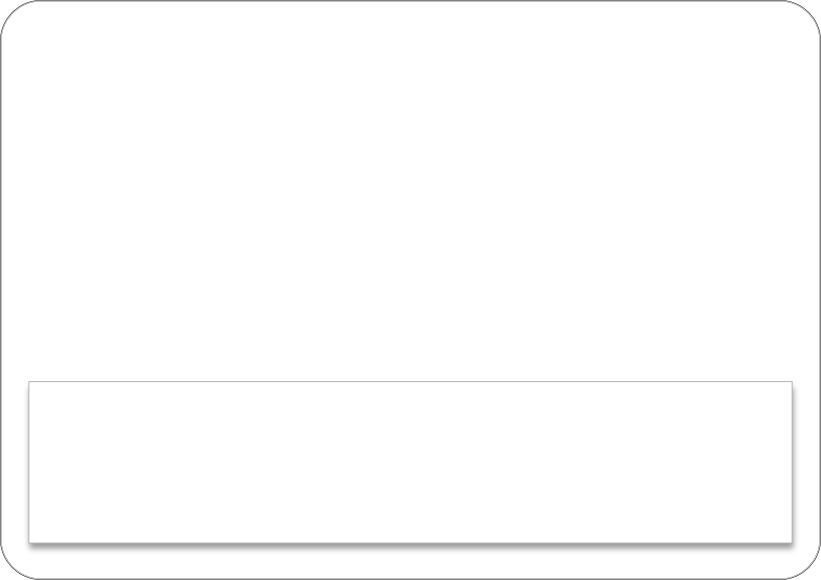
Analysis of the main musical elements (or concepts) in the chorus:
* Short phrases; each two bars long and consisting mainly of quavers (eighth notes) and semiquavers (sixteenth notes). Other note values are crotchets (quarter notes), dotted crotchets (dotted quarter notes) and a single dotted quaver (dotted eighth note) in the last bar. Only crotchet rests are used,
* Tied notes occur in almost every bar
* Mostly sylabic writing, with just a single example of melismatic word setting used on the word 'song'
* Mainly stepwise melody
* On the beat and Off the beat notes/lyrics
* Syncopation occurs in bars 1, 2, 3, 4, 7, 8 and 10 (produced by the tied notes in each of these bars and the dotted quaver between beats 2 & 3 in bar 10)
Range: The lowest note in the melody is Bb (the new key note) below middle C; the highest note is C, just over one octave higher.
Key: Bb major. This key has two flats: B flat and E flat. The chords in this key are: Bb major, C minor, D minor, Eb major, F major, G minor and A diminished. (For more information see Keys, Scales and Chords in the Reference Page of this website.)

Analysis of the main musical elements (or concepts) in verse 2:
* Short phrases consisting of quavers (eighth notes), crotchets (quarter notes), semiquavers (sixteenth notes) and two minims (half notes)
* Rests used are crotchet rest, quaver rest and dotted quaver rest
* Tied notes occur (6 times)
* Mainly sylabic word setting with some melismatic writing (the longest of which is used on the word 'Oh' in the second-
* Mainly stepwise melody
* The same two accompaniment chords are used in this verse as in verse 1 (F major and F sus4)
* On the beat and Off the beat notes/lyrics
* Anacrusis
* Syncopation occurs in bar 1 (between beats 2 & 3 and in the tied notes), bar 6 (between beats 1 & 2 and in the tied note on beat 3), bar 7 (in the last quaver beat tied over into bar 8), bar 8 (produced by tied notes) and bar 10 (produced by tied note on beat 1)

Range: The lowest note in the melody is F below middle C, the highest note is A above middle C (the same range as verse 1).
Key: F major

Analysis of the main musical elements (or concepts) in the Middle 8:
* Short phrases consisting of dotted crotchets (dotted quarter notes), quavers (eighth notes), crotchets (quarter notes), dotted quavers (dotted eighth notes), semiquavers (sixteenth notes) and two minims (half notes)
* Rests used are dotted minim rest (dotted half note rest (at the start)), crotchet rest (quarter note rest), quaver rest (eighth note rest) and semiquaver rest (sixteenth note rest)
* Tied notes occur (9 times)
* Mainly sylabic word setting with some melismatic writing
* A mixture of stepwise melody and small leaps are used
* Anacrusis in most bars
* Two alternating accompaniment chords are used throughout (G minor and C minor) with the exception of the Eb major chord in the first bar
* On the beat and Off the beat lyrics
* Syncopation occurs in bars 2, 3, 4, 7 & 8 (produced by tied notes) and in bar 9 (produced by the rests)
Range: The lowest note in the melody is G below middle C, the highest note is the D just over an octave above middle C (making it the highest note in the entire song). This middle 8 section contains the greatest vocal range; the lowest note is G below middle C, and the highest note, D, is one and a half octaves higher.
Key: G minor

Note: Middle 8 sections, by definition, are 8 bars long, but Chloe extended hers to ten bars simply because the natural flow and metre of the lyrics demanded it.

Analysis of the main musical elements (or concepts) in the Instrumental:
* Short phrases consisting of minims (half notes), a single dotted minim (dotted half note), two dotted crotchets (dotted quarter notes), crotchets (quarter notes), quavers (eighth notes), and semiquavers (sixteenth notes)
* Rests used (just one of each) are minim rest, dotted minim rest, quaver rest and semiquaver rest
* Tied notes occur (10 times)
* Melismatic (on the lyric 'Oh' in bars 1-
* Scat singing ('La da da da doo...')
* A mixture of stepwise and leaping melody is used
* Same chords as the chorus (Bb major, F major and Eb major)
* Syncopation occurs in bars 2, 3, 5, 8 & 9 (produced mainly by tied notes)
Range: The lowest note in the melody is Bb below middle C, the highest note is the C just over an octave higher
Key: Bb major

Note: the rhythm is much more varied in this section, which is largely the result of improvised singing.

Some modifications to the original music of the chorus were also made. These are:

Note: the song ends in the key of Bb major, but began in F major


When Chloe now sang all the main sections of her song in order she was pleased with the result. However, some sections seemed to run too closely together, making the music sound a little disjointed at these parts. Extra bars were therefore needed between these sections to join them together smoothly and create a little breathing space. Such 'joins' are known as link passages, and can consist of a chord progression, a few musical notes, a drum fill, or a combination of these.
Below is the complete song in music notation with each main section and link passage indicated (drum fills and hi-

Note: 1. Only the melody and guitar chords are shown, not the accompaniment parts. 2. in music notation sections are separated by double bar lines.

When she started recording 'I'm Arising', the first thing Chloe did was lay down a drum track in the tempo of her song (92 bpm). This is common practice with studio recordings since the drums provide a regular beat that live performers can follow, ensuring they play in strict time. Although not a drummer, Chloe easily created her own drum track using the excellent quality drumkit samples on her *MIDI sequencer. Experimenting with different combinations of these pre-
Listening to her completed drum track through headphones (to help her keep a regular tempo), Chloe then recorded the lead vocals whilst accompanying herself strumming chords on acoustic guitar. When this was complete, the song had three distinct parts: lead vocals, acoustic guitar and drums.
*For more information on using a MIDI sequencer, see Composing a Dance Track Using a MIDI Sequencer on this website.

Note: No drums play in the intro of 'I'm Arising,' so to ensure she was playing at the correct tempo during this section of the recording Chloe set a metronome click to play through her headphones at 92 bpm.

At this stage 'I'm Arising' already sounded impressive, but it needed the extra dimension of a bass part to give it some depth. Again Chloe played and recorded this part herself on bass guitar, beginning first of all by experimenting with melodic ideas and riffs using notes from scales in the key of each section. She then tried out these ideas by playing them over what had been recorded of the song so far and noted the ones that worked best. She soon discovered that a simple, subtle bass part worked best, one that wasn't too loud or too complicated. Then it was just a case of recording the part one section at a time onto the pre-
To do this the MIDI sequencer was used again, and soon the lead vocal, acoustic guitar and drum tracks were ovderdubbed with the new bass guitar part. This kind of music technology means a single musician can create the sound of an entire band just by recording one track on top of another. The same task can be carried out on a multi track recorder but, unlike sequencers, these do not have pre-

The next, and what was to be final part to be recorded was the backing vocals track.
As you have perhaps already detected when listening to the song, Chloe did her own backing vocals. Although you might think this would be an easy 'decorative' part of the composition, it in fact took a bit of patient work. First of all the decision had to be made where in the song these additional vocals were going to go (the obvious places are normally the chorus and any areas where extra emphasis is required). Then, the vocal harmony had to be considered; for example, were the backing vocals going to sing in unison with the lead vocal or at a higher or lower pitch? And would they have the same rhythm (homophonic) or create a countermelody? Good backing vocals really strengthen a song, but they have to be worked out carefully.

Grateful thanks are extended to Chloe Lawrence for allowing the use of her song for this workshop. ‘I’m Arising’ proves what can be achieved even by someone so young -
Remember, if you want to hear more of Chloe’s music just visit www.chloel.com

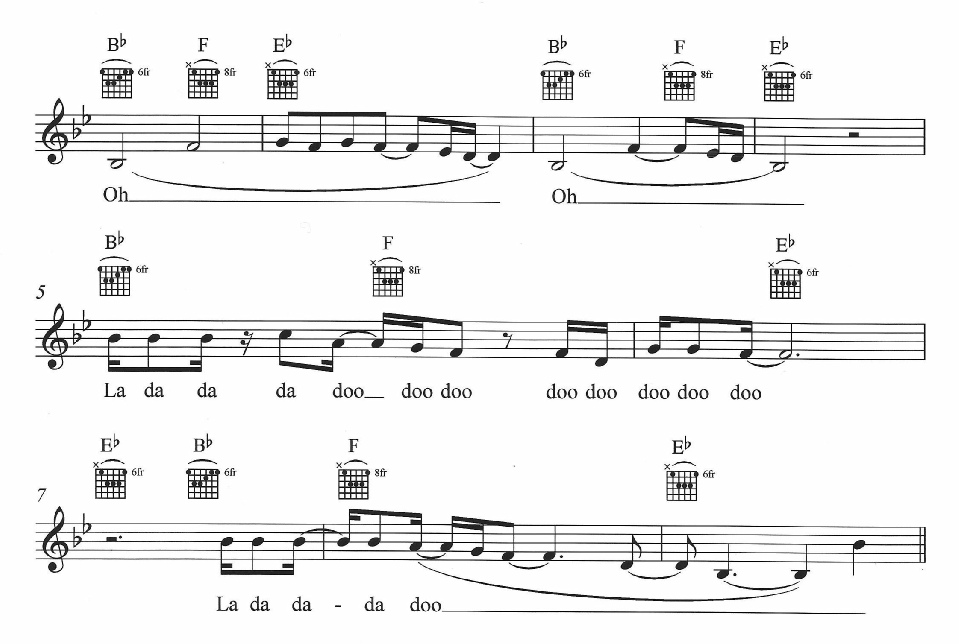

Instrumental (improvised vocal)
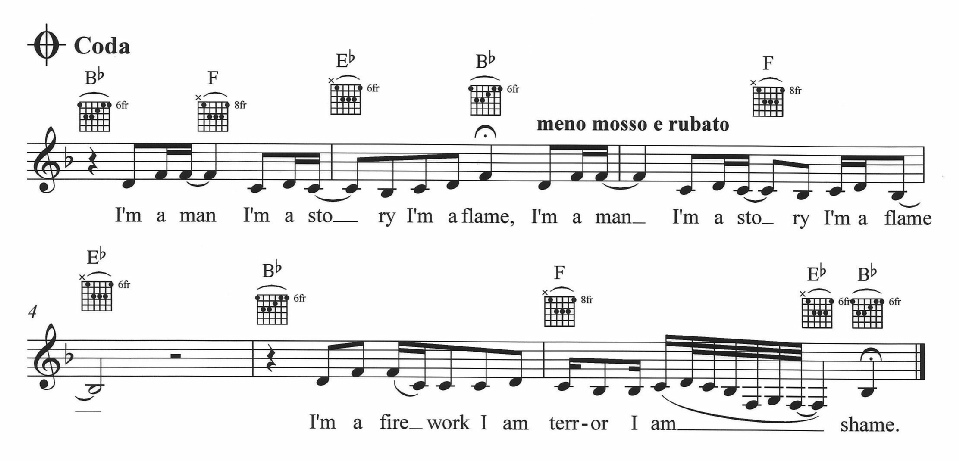

Coda


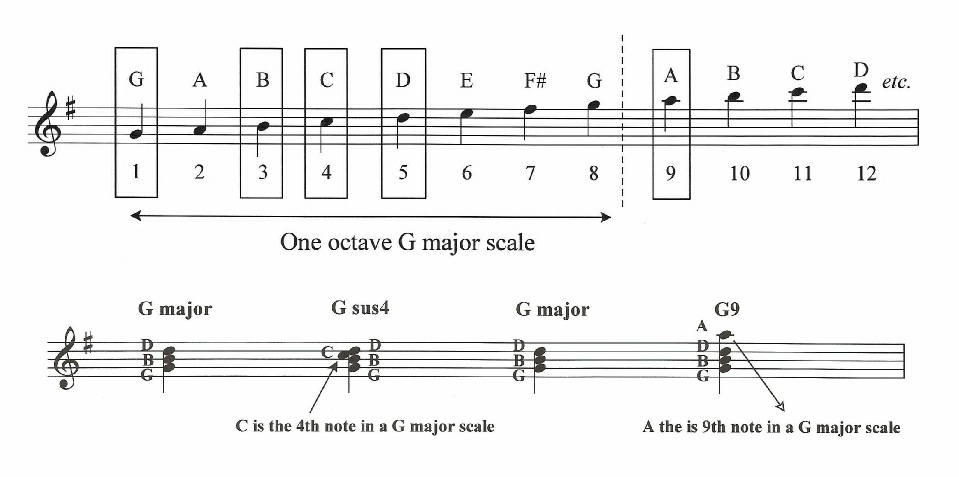
For an extra example, here are the sus 4 and added 9th chords in the key of G major:



















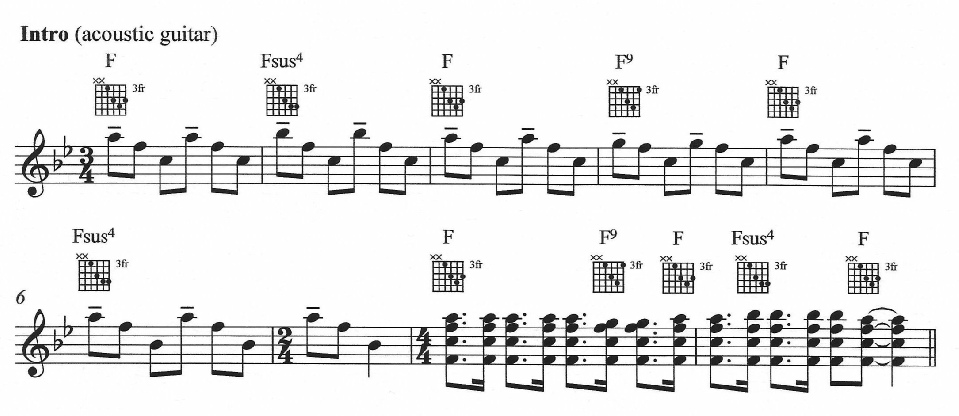

Intro










* The music stops suddenly in bar 2 at the pause symbol (or fermata) above the word 'flame.'
* Immediately after the pause at the end of bar 2 the Italian term meno mosso e rubato appears above the music on the words 'I'm a man...' This means 'less movement and not in strict time.' (You will hear that the music becomes suddenly slower and is no longer sung to a strict beat at this point when you listen to the Coda section).
* A melisma is used on the second-
